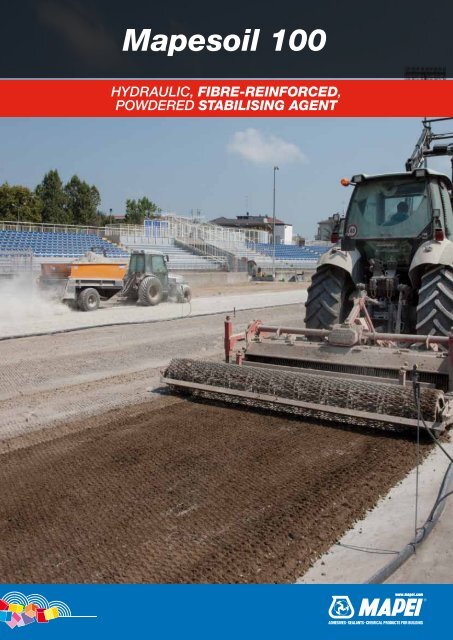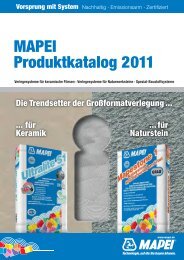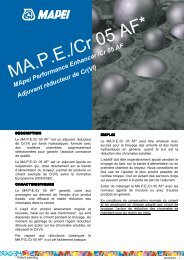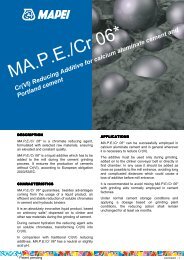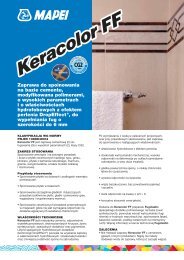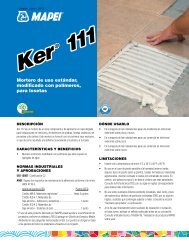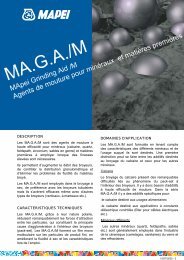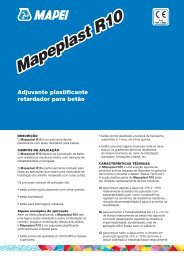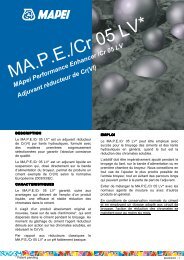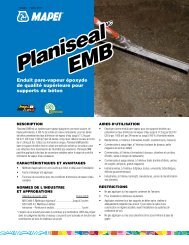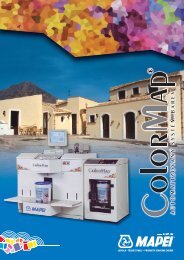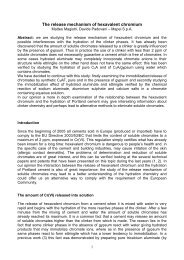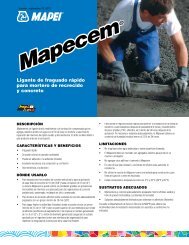Mapesoil 100 - Mapei
Mapesoil 100 - Mapei
Mapesoil 100 - Mapei
- No tags were found...
Create successful ePaper yourself
Turn your PDF publications into a flip-book with our unique Google optimized e-Paper software.
<strong>Mapesoil</strong> <strong>100</strong>HYDRAULIC, FIBRE-REINFORCED,POWDERED STABILISING AGENT
<strong>Mapesoil</strong> <strong>100</strong>MAPEI TECHNOLOGY FOR MAKINGSUBSTRATES FOR SYNTHETICGRASS PLAYING SURFACESThe number of new playing fields installed using the latestgeneration of synthetic grass (for football, tennis, hockey,etc.) has increased significantly over the last decade,thanks to the considerable advantages which a syntheticsurface offers compared with natural grass, as well as tothe new systems.MAPEI has a complete system of products availablefor installers of synthetic grass which offers a validcontribution to the high quality standards of new playingfields, from consolidating the substrate and bonding thesynthetic grass, right up to the addition of the stabilisinggranules. MAPEI research has developed a groundstabilisation and consolidation system to make substratesfor synthetic grass playing surfaces, <strong>Mapesoil</strong> <strong>100</strong>, aformulation specifically used for playing surfaces.What is <strong>Mapesoil</strong> <strong>100</strong>?<strong>Mapesoil</strong> <strong>100</strong> is a hydraulic, fibre-reinforced, powderedstabilising agent used to make substrates for syntheticgrass playing fields through a process of stabilisation.The main areas of use for <strong>Mapesoil</strong> <strong>100</strong> are:↳ Substrates for synthetic grass playing surfaces(e.g. football pitches, etc.);↳ Consolidating and stabilising substrates for existingplaying surfaces (e.g. clay tennis courts);↳ Cold-recycling substrates for playing surfaces(e.g. existing bitumen conglomerate substrates).Application phases for <strong>Mapesoil</strong> <strong>100</strong>1 2TopsoilingSpreadingTopsoiling of the old natural grass surfaceSpreading on the <strong>Mapesoil</strong> <strong>100</strong> with a sandblaster
How does <strong>Mapesoil</strong> <strong>100</strong> work?Through a process of consolidation, the use of <strong>Mapesoil</strong> <strong>100</strong>allows the physical and mechanical properties of the material(aggregate and/or the ground) requiring stabilisation tobe modified and improved, such as its workability, loadbearingcapacity, durability and resistance to erosion.↳ The time required to make the substrate for the playingsurface is reduced, thanks to the movement of a loweramount of material;↳ Only readily available tools normally used inagriculture are required (ploughs, harrows, stoneburiers, sandblasters, etc.).What’s new about <strong>Mapesoil</strong> <strong>100</strong>?Thanks to its special formulation developed and perfectedin the <strong>Mapei</strong> research laboratories, with <strong>Mapesoil</strong> <strong>100</strong>:↳ A wide range of ground types may be treated;↳ The material already present on site (in the caseof existing pitches) or recycled material may be used,thus avoiding the use of virgin aggregates;↳ The thickness treated compared with conventionalstabilisation methods (lime or cement) may bereduced, but with the same performance;Where to use<strong>Mapesoil</strong> <strong>100</strong> is used for making playing fields and itsmain areas of use are:↳ For making substrates for synthetic grass playingsurfaces (e.g. football pitches);↳ Consolidating and stabilising substrates for existingplaying surfaces (e.g. clay tennis courts);↳ Cold-recycling substrates for playing surfaces madeusing bitumen conglomerate.34 5MixingWettingMixing in the <strong>Mapesoil</strong> <strong>100</strong> with a ploughWetting the ground
How is <strong>Mapesoil</strong> <strong>100</strong> applied?The application of <strong>Mapesoil</strong> <strong>100</strong> consists of mixing itdirectly with the material to be treated and, if required, withwater. The phases are as follows:• Preparation and, where necessary,breaking up of the ground and topsoil;• Spreading on the <strong>Mapesoil</strong> <strong>100</strong>;• Mixing in the <strong>Mapesoil</strong> <strong>100</strong> and wetting the ground;• Compacting;• Levelling and shaping;• Curing.AdvantagesThe use of <strong>Mapesoil</strong> <strong>100</strong> technology for substratesfor synthetic grass playing surfaces offers numeroustechnical and economic advantages, such as:↳ Ease of application;↳ The thickness treated may be considerably reduced(8 cm) with the same performance;↳ The ground available on site and/or recycled materialmay be used, reducing movement of materialsand energy consumption;↳ The time required to make the substrate for the playingsurface may be reduced;↳ The durability of the treatment may be increased.Levelling off6 7CompactingLevelling off Compacting Synthetic grass playing field with horizontaldrainage made using <strong>Mapesoil</strong> <strong>100</strong>
System for layingsynthetic grass playing fieldsadhesiveUltrabond Turf PU 1Kjointing stripUltrabond Turf Tape <strong>100</strong>flexible underlay with horizontal channels for drainageShock Padfibre-reinforced, powdered stabilising agent<strong>Mapesoil</strong> <strong>100</strong>
HEADQUARTERSMAPEI SpAVia Cafiero, 22 - 20158 MilanTel. +39-02-37673.1Fax +39-02-37673.214Internet: www.mapei.comE-mail: mapei@mapei.itC.P. MK 663330 (GB) 10/2011


